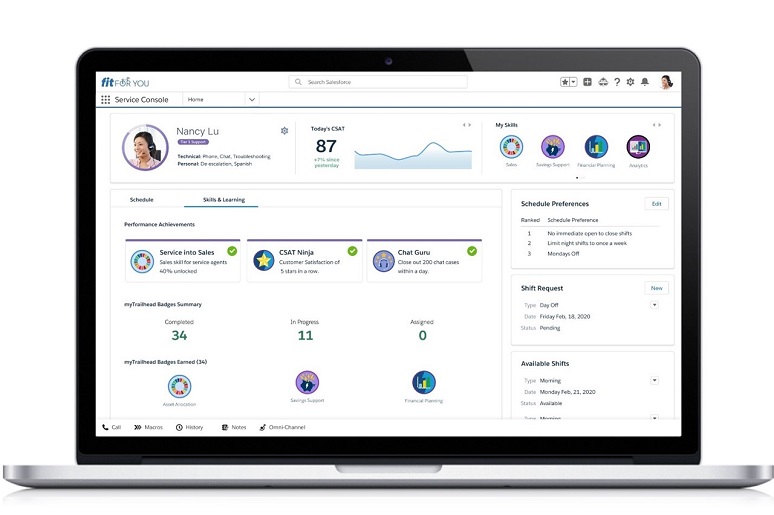Dreamforce to You 2020, the virtual version of this year’s annual Salesforce conference, begins today with keynote presentations and continues at DreamTX, a four-day learning event from Dec. 14-17. Among the news the company issued in conjunction with the big day is the introduction of Service Cloud Workforce Engagement.
What Is Workforce Engagement?
In the beginning, let’s say the 1990s, was call monitoring and workforce management (WFM) software, typically developed and sold by separate companies. Somewhere in the early 2000s, vendors began applying the term workforce optimization (WFO) to four software elements focused on agent performance and business process performance: WFM, performance management, quality monitoring (an upgrade from mere call monitoring), and e-learning. The WFM and QM began vendors expanding their single solution offerings to include more elements.
In 2017, Gartner broadened the playing field even further, defining a new term,
workforce engagement management (WEM). Today, Gartner characterizes WEM as including support for:
- Recruiting and onboarding
- Evaluation and improvement — i.e., QM
- Time management — i.e., WFM
- Assistance and task management
- Metrics and recognition, which includes gamification
- Voice of the employee
Gartner’s WEM labeling came about as contact center application providers worked toward including some or all of the above elements into their suites, especially their cloud solutions. NICE’s May 2016
acquisition of contact center as a service (CCaaS) provider inContact provides the best example of that early market momentum toward WEM. Four years later, fellow CCaaS leaders
Genesys,
Five9, and
Talkdesk have all committed considerable resources to building and/or acquiring WEM portfolio elements. Meanwhile, Cisco is using its August 2019 acquisition of
CloudCherry (now Webex Experience Manager) as a lynchpin in its developing Webex Contact Center strategy.
Service Cloud Workforce Engagement
Now that we’ve established a common understanding of what the term “workforce engagement” means, it is hopefully easier to understand Salesforce’s entry into the market. In today’s release, Salesforce highlights three capabilities of Service Cloud Workforce Engagement:
- Service Forecast for Customer 360 uses AI based on data from the Salesforce platform and integrated third-party tools to help service leaders organize their workforce and predict how many requests will come into the contact center in real-time, across all digital channels and regions.
- Omnichannel Capacity Planning enables service leaders to balance staffing needs across any digital channel — from phone, email, web chat, and text to social channels — by assigning the right agents at the right time based on their skills and availability.
- Personalized Agent Engagement provides real-time coaching and on-demand training from anywhere by integrating myTrailhead, Salesforce’s online learning platform, directly into the Service Console. To increase agent engagement and performance, companies can quickly onboard and continually train agents by delivering bite-size, guided learning paths directly in the agent’s workspace during their shift.
As described in a pre-briefing by Uri Pintov, senior director of product management at Salesforce, “We've invested a lot over the last few months. What you see here are core pieces of classic WFM along with more modern features around engagement with the agents.” Note that in the descriptions, Salesforce highlights AI and omnichannel, emphasizing that Service Cloud Workforce Engagement is a next-gen WEM tool.
As seen in the picture of the Service Cloud Workforce Engagement agent interface at the top of this post, another important attribute of the product is that it lives within the Salesforce desktop. While some contact center vendors, notably NICE inContact, have tightly integrated their WEM solutions with the Salesforce desktop, it is hard for partners to replicate the ease of a native solution.
Rollout Schedule and Pilot Customers
As is typical for a major product introduction at Salesforce, first comes the announcement at Dreamforce then the pilot testing in the next release before general availability thereafter. In the case of Service Cloud Workforce Engagement, announced during today’s opening ceremony, a full pilot will begin with the Spring 21 release (scheduled for February) and general availability with the Summer 21 release (June).
As is also standard practice, Service Cloud Workforce Engagement entered product pilot in October, as part of the Winter 21 release. As a result, Salesforce already has three customer references:
Canyon Bicycles, Fisher & Pakel, and
Xero. Thomas Kohl, head of customer service at Canyon Bicycles, has this to share: “…with Service Cloud Workforce Engagement, we can leave spreadsheets behind… .”
While adoption of QM tools in contact/service centers today is typically in excess of 90%, the adoption rate of WFM tools has traditionally been significantly lower, especially in contact centers with fewer than 200 or so agents. Instead, those contact centers are usually using the spreadsheets to which Kohl refers.
Even companies with hundreds of customer service professionals continue to use spreadsheets in some capacity — even if they have implemented a WFM solution. Why? Because as mentioned above, early tools were voice-only, and they don’t handle digital interactions effectively. However, adoption rates are improving thanks to cloud WFM, which dramatically improves the deployment cost and speed compared to a premises solution.
So, why is Salesforce entering the WEM market? Melissa Matross, Salesforce SVP of product management answers this question today in a Salesforce blog post. “As consumer behavior and expectations continue to shift and become more complex with the COVID-19 pandemic — Salesforce’s role in the customer service industry is also evolving,” she wrote.
The shift in consumer behavior is toward the use of more digital channels and, by companies, a higher proportion of work-at-home agents. Engagement in a distributed workforce means enabling agents to ask questions and get support within their own teams. For thousands of contact centers that have not yet deployed workforce management, Salesforce is offering a new alternative — mapped to their CRM system instead of their contact center software.










